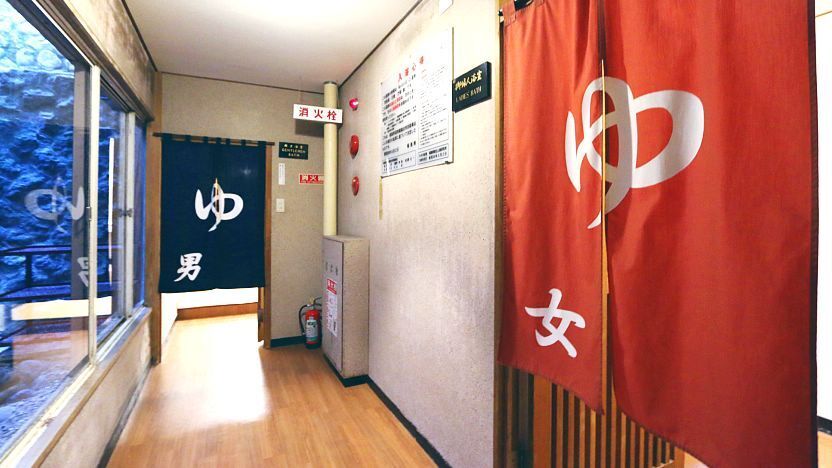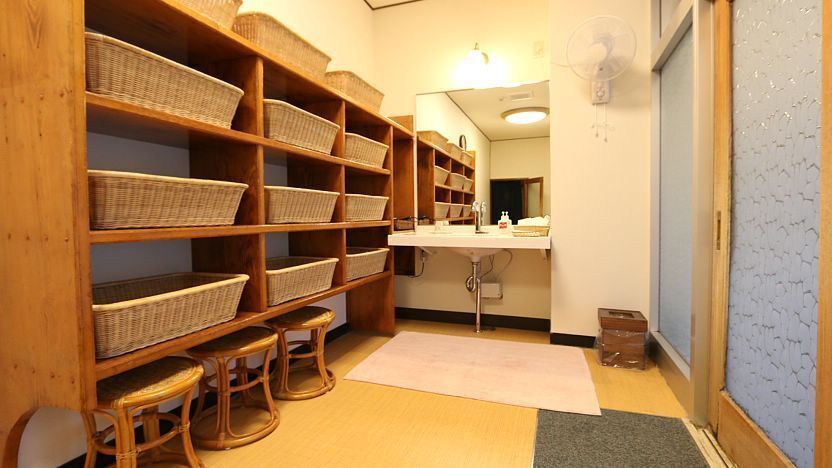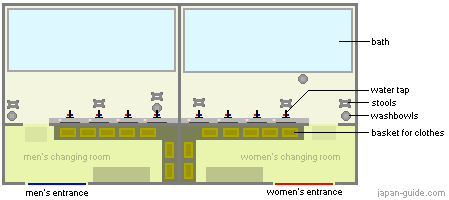How to take an onsen bath

Finding the changing room
The first step in taking a hot spring bath is to locate the changing areas, which are almost always gender-segregated rooms outside the bathing areas. The men's and women's changing areas are typically identified by the curtains that hang outside. Blue curtains are often used for the men's bath and red for the women's, but take care as that is not always the case.
The following graphic shows how a typical curtain may look like and the meanings of the kanji characters that may be present to specify the genders.

In the changing room
Changing rooms provide a place to remove your clothes and usually have shelves and baskets or lockers where you can store your belongings as you bathe. There may also be a sink and possibly a few amenities such as a hair dryer or tissue paper. Coin lockers or safe boxes may also be available where you can store your valuables in a more secure place.

Towels
Two types of towels are popularly used at Japanese baths: small towels are used inside the bath for washing your body and for covering yourself for a little privacy when moving about the bathing areas, while large towels are left in the changing room and used to dry yourself after the bath. When staying at a ryokan or hotel, the towels are usually provided in your room or in the bath, while at public bath houses they are usually available for sale or rental for a few hundred yen, although you are welcome to bring your own as well.

Taking a bath
Below is a description of the common way of taking a hot spring bath. The actual rules may differ slightly between different establishments.
The typical layout of a small indoor bath:

- Take off all your clothes in the changing room and place them into a basket together with your large bath towel. Coin lockers for valuables are often available.
- Hot springs are enjoyed naked, and swimming suits are not allowed. However, it is the custom to bring a small towel into the bathing area, with which you can enhance your privacy while outside of the water.
- Before entering the bath, rinse your body well with water from a trough, tap or the bath itself using a bowl or from a shower.
- Enter the bath and soak. Note that the bath water can be very hot, typically 40-44 degrees Celsius (or 104-111 degrees Fahrenheit). If it feels too hot, try to enter very slowly and move as little as possible.
- Make sure to keep your small towel out of the water. Many bathers set theirs at the side of the bath or fold it up and place it on their head.
- Refrain from talking loudly, swimming and submerging your head. Those with long hair should tie it up before entering the bath.
- Try out different baths (if available) and take breaks. Avoid sitting with your behind on the edge of the bath tub as others will rest their heads there.
- After you finished soaking, it is recommended not to rinse your body with tap water for the hot spring water's minerals to have full effect on your body.
- Use your small towel to pat yourself dry before re-entering the changing room in order to keep the floor dry. You can dry yourself further there with your large bath towel.
Cleaning your body is not a primary purpose of hot spring bathing, especially when taking multiple baths per day. To the opposite: the primary purpose of visiting an onsen is to dirty your body with the minerals provided by Mother Earth.
Nevertheless, many onsen baths provide space for people to clean themselves, and shampoo and body soap are often provided. When you clean yourself, make sure that you rinse yourself well afterwards so that no soap gets into the bath water. Sit on a low stool and avoid spraying water on other bathers while using the shower. Tidy up your space after you are finished.

Health concerns
Despite its relaxing nature, hot spring bathing can be demanding, and bathers should take care not to overdo it, especially people with high blood pressure and other health conditions.
The bath water tends to be hot, and taking in all that heat can be taxing. It is recommend to bathe in short sessions, taking breaks every so often to cool down. Drink plenty of water before and after a bath and avoid alcoholic drinks, which dehydrate your body. It is also recommended not to bathe immediately after a meal.
Furthermore, many hot spring baths come with slippery floors, while some hot spring waters are cloudy or non-transparent, making underwater steps difficult to spot. Make sure to enter the tubs slowly and move around the baths carefully to avoid slip and fall injuries.

Questions? Ask in our forum.